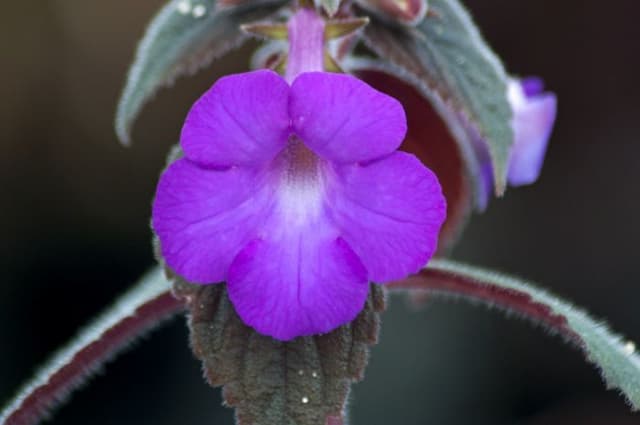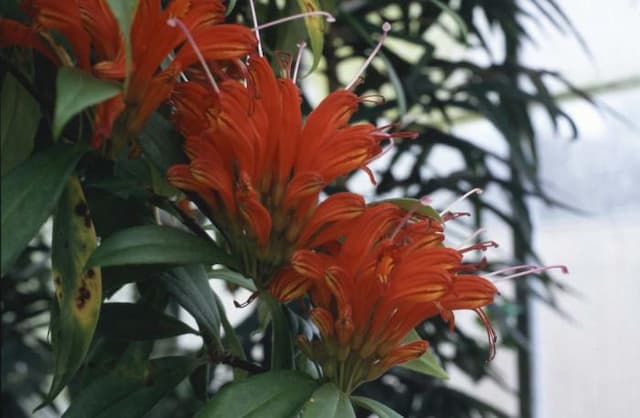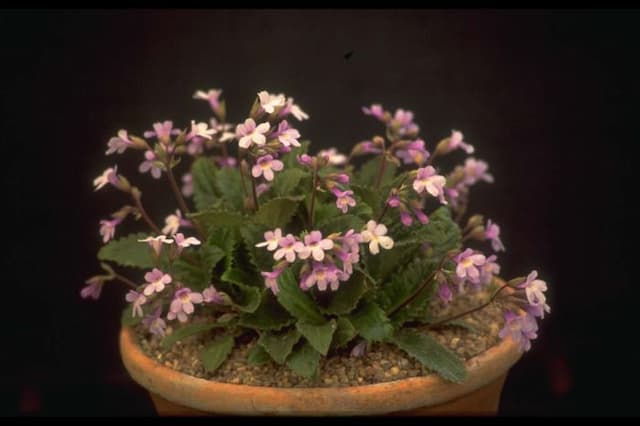Orchid Cactus × Achimenantha 'Inferno'

ABOUT
× Achimenantha 'Inferno', commonly known as the 'Inferno' orchid cactus, is a hybrid plant known for its striking and vivid appearance. The plant typically bears long, pendulous stems that are characteristic of many hybrids in its lineage. The foliage is often a vibrant green, displaying a lush and healthy vigor. The most eye-catching aspect of 'Inferno' is its floral display. The flowers emerge from the stems as extravagant bursts of color. They offer a fiery palette, hence its name 'Inferno,' with petals that may blend hues of reds, oranges, and yellows—a mix that resembles the dynamic colors of a flame. The petals are usually broad and can sometimes have a slight ruffling or undulation at their margins, adding to the visual complexity of the flower. The blooms may also feature a contrasting throat color, highlighting the tropical look of the flower. Amidst the colorful petals, the stamens and pistils at the center of the flowers add an intricate detail to the overall floral composition. The stamens with their pollen-covered anthers halo around the pistil, providing not just a functional aspect of the plant’s reproductive system, but also a decorative feature. The overall appearance of the 'Inferno' orchid cactus is one of dramatic beauty, with its cascading stems and showy, colorful blooms that can bring a touch of the exotic to any setting. It is revered by plant enthusiasts and gardeners for its ornamental qualities and the tropical flair it introduces to a collection.
About this plant
 Names
NamesSynonyms
Magic Flower, Ornamental Pepper
Common names
× Achimenantha 'Inferno'.
 Toxicity
ToxicityTo humans
× Achimenantha 'Inferno', commonly known as the inferno plant, does not have a well-documented toxicity profile for humans in widely available horticultural or toxicological literature as of my last update. In the absence of specific information, it is generally recommended to exercise caution and avoid ingesting parts of ornamental plants. Symptoms from ingesting plants that are toxic can range from nausea, vomiting, and diarrhea to more severe symptoms like difficulty breathing or altered heart rates, depending on the plant involved. If ingestion occurs and poisoning is suspected, medical attention should be sought immediately.
To pets
× Achimenantha 'Inferno', commonly known as the inferno plant, does not have a well-documented toxicity profile for pets in widely available veterinary or toxicological literature as of my last update. However, symptoms of plant poisoning in pets can include vomiting, diarrhea, drooling, lethargy, and abdominal pain. If pets ingest parts of plants of unknown toxicity or if they show signs of poisoning, a veterinarian should be consulted immediately to ensure proper care and treatment.
 Characteristics
CharacteristicsLife cycle
Perennials
Foliage type
Evergreen
Color of leaves
Green
Flower color
Red
Height
6-12 inches (15-30 cm)
Spread
6-12 inches (15-30 cm)
Plant type
Hybrid
Hardiness zones
9
Native area
Cultivar
Benefits
 General Benefits
General Benefits- Decorative Appeal: Offers striking flowers and lush foliage, adding aesthetic value to indoor and outdoor spaces.
- Easy Maintenance: Requires minimal care, making it suitable for busy plant owners and beginners.
- Mood Enhancement: Bright, colorful blooms can help improve mood and create a pleasant environment.
- Habitat for Wildlife: Attracts pollinators like bees and butterflies when planted outdoors, supporting local ecosystems.
- Interior Design Versatility: Compact size allows it to be used in a variety of interior design schemes.
- Seasonal Interest: Provides year-round interest with its evergreen leaves and seasonal flowering.
- Gift Potential: Makes for an attractive and thoughtful gift for plant enthusiasts and gardeners.
- Learning Opportunity: Offers horticultural interest for those wanting to learn about hybrid plant cultivation.
 Medical Properties
Medical PropertiesThis plant is not used for medical purposes.
 Air-purifying Qualities
Air-purifying QualitiesThis plant is not specifically known for air purifying qualities.
 Other Uses
Other Uses- Educational tool: The × Achimenantha 'Inferno', due to its hybrid nature, can be used in educational settings to illustrate the concept of plant hybridization, genetics, and the diversity of flowering plants.
- Photography subject: The striking colors of the × Achimenantha 'Inferno' make it an excellent subject for botanical photography and can be used in workshops and classes focusing on macro photography.
- Art inspiration: The vibrant blooms can serve as a source of inspiration for artists, whether they are painting still life works or designing patterns for textiles.
- Therapeutic horticulture: Gardening with × Achimenantha 'Inferno' can be included in therapeutic horticulture programs, promoting wellbeing through active interaction with plants.
- Floral arrangement: The flowers can be used in non-traditional floral arrangements or ikebana, a Japanese art of flower arrangement that emphasizes form and balance.
- Color dye: The pigments from the flowers may be used in a natural dye-making process for fabrics or crafts, though they might not be as potent as traditional dye plants.
- Event decor: This plant can be utilized as part of event decorations, such as centerpieces for weddings or other celebrations, enhancing the atmosphere with its vivid colors.
- Culinary decoration: Although not for consumption, the flowers can be used as a decorative garnish for dishes in high-end culinary presentations.
- Collectible: Plant enthusiasts and collectors who specialize in hybrid plants may value the × Achimenantha 'Inferno' for its unique attributes and rarity.
- Set design: The plant could be used in theater productions or movie sets to add a pop of color or to depict a lush, exotic environment.
Interesting Facts
 Feng Shui
Feng ShuiThe Achimenantha 'Inferno' is not used in Feng Shui practice.
 Zodiac Sign Compitability
Zodiac Sign CompitabilityThe Achimenantha 'Inferno' is not used in astrology practice.
 Plant Symbolism
Plant Symbolism- Passion: The fiery appearance of Achimenantha 'Inferno', often referred to as 'Inferno', is commonly associated with strong emotions and passion.
- Intensity: Its intense red flowers symbolize a deep intensity of feelings or situations.
- Danger: Red is often a color of warning, so the 'Inferno' might symbolize danger or the need for caution.
- Transformation: As a hybrid plant, Achimenantha 'Inferno' could symbolize the blending of elements and transformation.
 Water
WaterMagic fire plants should be watered thoroughly, allowing the top inch of soil to dry out before watering again. Typically, this means watering the plant about once a week, but this can vary depending on environmental conditions such as temperature and humidity. It’s important to use lukewarm water and to water directly onto the soil, avoiding the leaves to prevent any fungal diseases. Aim to provide approximately 8-16 ounces of water per week, making sure the plant isn’t left sitting in water as this can lead to root rot.
 Light
LightMagic fire plants thrive in bright, indirect sunlight. The best spot for the plant is near an east or west-facing window where it can receive ample but diffused light. Avoid placing it in direct sunlight, especially during the harsh midday sun, to prevent scorching the foliage.
 Temperature
TemperatureMagic fire plants prefer warm conditions, ideally between 65 and 75 degrees Fahrenheit. They can tolerate a range of temperatures but should not be exposed to temperatures below 50 degrees Fahrenheit or above 85 degrees Fahrenheit, as extreme temperatures can stress the plant.
 Pruning
PruningPruning Magic fire plants encourages bushier growth and should be done as needed to remove dead or yellowing leaves. The best time for pruning is in the spring before the growing season begins. You can also pinch back the tips of the plant to promote more side shoots and a fuller appearance.
 Cleaning
CleaningAs needed
 Soil
SoilThe × Achimenantha 'Inferno', commonly known as the Inferno orchid cactus, thrives in a well-draining, porous soil mix consisting of equal parts peat, perlite, and pine bark with a slightly acidic to neutral pH of around 6.0 to 7.0.
 Repotting
RepottingInferno orchid cacti should generally be repotted every two to three years to refresh the soil and accommodate root growth.
 Humidity & Misting
Humidity & MistingInferno orchid cacti prefer a humidity level of around 50-60%, which is slightly higher than the average indoor environment.
 Suitable locations
Suitable locationsIndoor
Place in bright, indirect light with some humidity.
Outdoor
Shield from direct sun; keep in warm, sheltered spot.
Hardiness zone
10-11 USDA
 Life cycle
Life cycle× Achimenantha 'Inferno', commonly known as the "Inferno" hybrid, starts its life cycle when a seed germinates in warm, moist soil, during which the radicle emerges to form the root system. As the plant grows, it develops a rosette of leaves and stems that support the photosynthesis process necessary for growth and development. Upon reaching maturity, the "Inferno" produces striking flowers that are a major attraction for pollinators, although many hybrids are primarily propagated through vegetative means such as cuttings or division. After pollination and fertilization, if occurs, seed pods may develop although hybrid seeds may not come true to the parent form. Once the growing season is over, the plant enters a period of dormancy, where growth slows down, and it conserves energy, typically corresponding with cooler temperatures or dry seasons. With the return of favorable growing conditions, the cycle begins anew with the emergence of new growth, buds, and the continuation of the species.
 Propogation
PropogationPropogation time
Spring-Early Summer
Propogation: The × Achimenantha 'Inferno', commonly known as the Inferno orchid cactus, can be propagated by means of cuttings, which is the most popular method. To propagate the Inferno orchid cactus using cuttings, take a healthy stem segment that includes at least two to three jointed sections. Allow the cutting to dry for a day or two to form a callus on the cut surface, reducing the chance of rot when planted. Once callused, insert the base of the cutting into a well-draining soil mix. Water sparingly until roots develop, being careful to not overwater as this might lead to rot. Rooting typically takes place within a few weeks, occurring optimally during the warmer months when the plant is actively growing.









